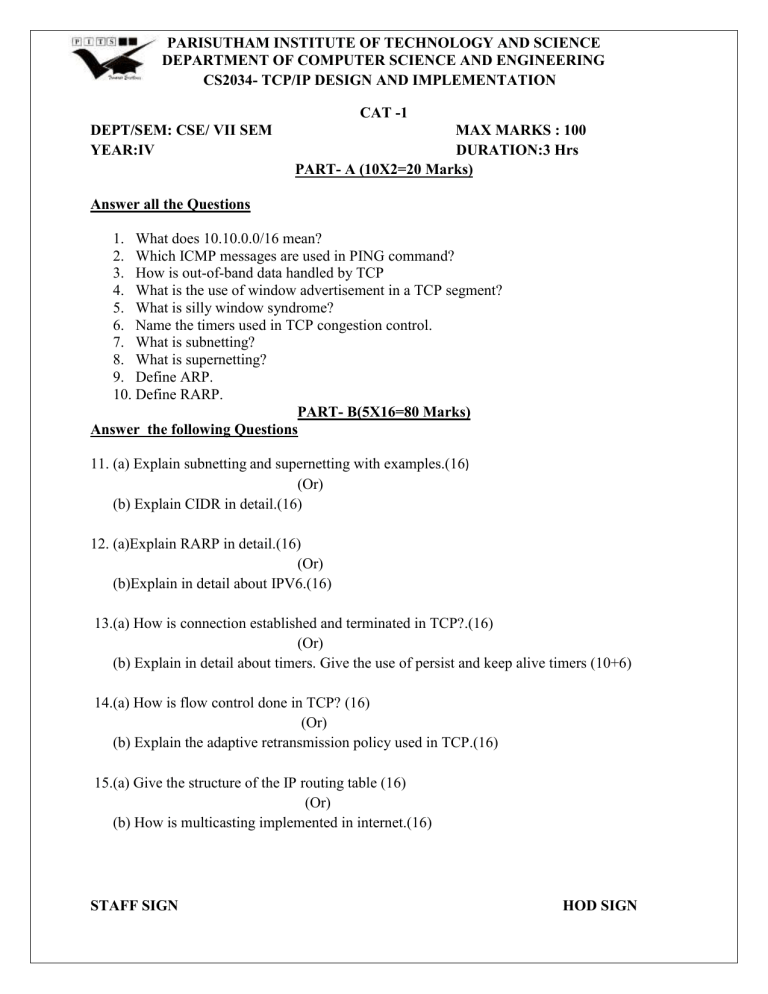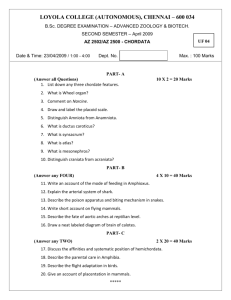cat1 ooad

PARISUTHAM INSTITUTE OF TECHNOLOGY AND SCIENCE
DEPARTMENT OF COMPUTER SCIENCE AND ENGINEERING
CS2034- TCP/IP DESIGN AND IMPLEMENTATION
CAT -1
DEPT/SEM: CSE/ VII SEM MAX MARKS : 100
YEAR:IV DURATION:3 Hrs
PART- A (10X2=20 Marks)
Answer all the Questions
1.
What does 10.10.0.0/16 mean?
2.
Which ICMP messages are used in PING command?
3.
How is out-of-band data handled by TCP
4.
What is the use of window advertisement in a TCP segment?
5.
What is silly window syndrome?
6.
Name the timers used in TCP congestion control.
7.
What is subnetting?
8.
What is supernetting?
9.
Define ARP.
10.
Define RARP.
PART- B(5X16=80 Marks)
Answer the following Questions
11. (a) Explain subnetting and supernetting with examples.(16 )
(Or)
(b) Explain CIDR in detail.(16)
12. (a)Explain RARP in detail.(16)
(Or)
(b)Explain in detail about IPV6.(16)
13.(a) How is connection established and terminated in TCP?.(16)
(Or)
(b) Explain in detail about timers. Give the use of persist and keep alive timers (10+6)
14.(a) How is flow control done in TCP? (16)
(Or)
(b) Explain the adaptive retransmission policy used in TCP.(16)
15.(a) Give the structure of the IP routing table (16)
(Or)
(b) How is multicasting implemented in internet.(16)
STAFF SIGN HOD SIGN
PARISUTHAM INSTITUTE OF TECHNOLOGY AND SCIENCE
DEPARTMENT OF COMPUTER SCIENCE AND ENGINEERING
CS2034- TCP/IP DESIGN AND IMPLEMENTATION
CAT -1
DEPT/SEM: CSE/ VII SEM MAX MARKS : 100
YEAR:IV DURATION:3 Hrs
PART- A (10X2=20 Marks)
Answer all the Questions
1.
Define fragmentation .
2.
What are the advantages of doing reassembly at the ultimate destination instead of doing it after the datagram travels across one network?
3.
Differentiate classfull and classless addressing?
4.
What is meant by masking?
5.
What is meant by connectionless protocol?
6.
State the functions of routing table.
7.
What are the fields included in the routing table?
8.
What is meant by maximum transfer unit?
9.
How the errors are detected in IP?
10.
What is Unicast,multicast,broadcast communication?
PART- B(5X16=80 Marks)
Answer the following Questions
11.
a)Explain in detail about classfull and classless addressing.(16)
(Or) b) Explain in detail about internet protocol.(16)
12.
a)Explain about keep alive timer(16)
(Or) b)Explain in detail about the necessities of persist timer.(16)
13.a) Give a detailed discussion on IP routing.(16)
(Or)
b)Give the steps in Transmission Control Protocol(16).
14.a)What is the importance of ICMP.(6+10)
(Or)
b)Give justifications on the ICMP error processing (16)
15.a)Explain in detail about fragmentation of datagrams.(16)
(Or) b)Explain in detail about reassembly mechanisms.
(16)
STAFF SIGN HOD SIGN
PARISUTHAM INSTITUTE OF TECHNOLOGY AND SCIENCE
DEPARTMENT OF COMPUTER SCIENCE AND ENGINEERING
CS6502- OBJECT ORIENTED ANALYSIS AND DESIGN
CAT -1
DEPT/SEM: CSE/ V SEM MAX MARKS : 100
YEAR:III DURATION:3 Hrs
PART- A (10X2=20 Marks)
Answer all the Questions
1.
List the relationships used in class diagram.
2.
What is the use of System sequence diagram?
3.
Define Aggregation and Composition.
4.
What is a Domain Model?
5.
Define the inception step.
6.
What is Object Oriented Analysis and Design?
7.
Give the meaning of Event, State and transition.
8.
Differentiate tier, layer and partition.
9.
What is an elaboration?
10.
Define generalization.
Answer the following Questions
PART- B(5X16=80 Marks)
11.
a) What is UML? Explain the types of UML diagrams. (16)
(Or)
b) Explain Use case diagram with example. (16)
12.a) What is UPP? Explain the different phases of Unified Process. (16)
(Or)
b) What are the strategies used to identify conceptual classes and descriptive classes?
Explain with example. (16)
13.a) Explain about UML activity diagram and its notations with an example(16)
(Or)
b) Differentiate sequence diagram and use case diagram with example(16).
14.a)Explain the UML Package Diagram(16).
(Or)
b) Explain about UML Class diagram with an example
15.a) Explain about UML Interaction diagram with an example(16)
(Or)
b)Explain include, extend and generalization in detail.
STAFF SIGN HOD SIGN
PARISUTHAM INSTITUTE OF TECHNOLOGY AND SCIENCE
DEPARTMENT OF COMPUTER SCIENCE AND ENGINEERING
CS6502- OBJECT ORIENTED ANALYSIS AND DESIGN
CAT -1
DEPT/SEM: CSE/ V SEM MAX MARKS : 100
YEAR:III DURATION:3 Hrs
PART- A (10X2=20 Marks)
Answer all the Questions
1.
Define elaboration.
2.
What is Domain Model and domain layer?
3.
Differentiate Aggregation and Composition.
4.
What is a inception?
5.
Define class diagram.
6.
What is ooad and UML?
7.
Differentiate Event, State and transition.
8.
Differentiate tier, layer and partition.
9.
What is System sequence diagram?
10.
Define generalization.
PART- B(5X16=80 Marks)
Answer the following Questions
11.
a) List various UML Diagrams and explain each purpose with example. (16)
(Or)
b) Explain with an example, how use case modeling is used to describe functional requirements. Identify the actors, scenario and use cases for the example. (16)
12.a) Briefly explain the different phases of Unified Process. (16)
(Or)
b) Describe the strategies used to identify conceptual classes. Describe the steps to create a domain model used for representing conceptual classes. (16)
13.a) Explain about UML activity diagram with an example(16)
(Or)
b) Illustrate with an example, the relationship between sequence diagram and use cases
(16).
14.a)Explain the use and notations of UML Package Diagram(16).
(Or)
b) Explain about association, association class, classifier and other notations of class diagram with an example(16).
15.a) Explain about Sequence and communication diagram with an example(16)
(Or)
b) Explain the associations that are used to make relation between use cases in detail.(16)
STAFF SIGN HOD SIGN









